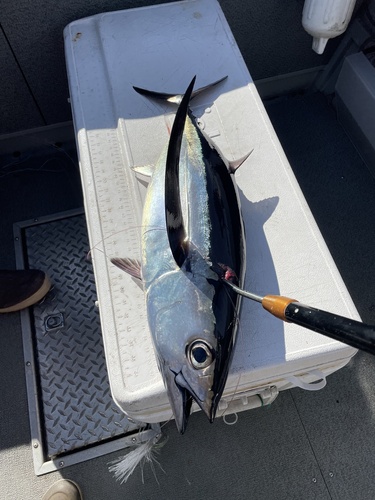
Albacore
The Atlantic bluefin tuna (Thunnus thynnus) is a magnificent and highly migratory species of tuna found in the Atlantic Ocean. Renowned for its size, speed, and commercial value, it is a top predator in the marine ecosystem. This species plays a critical role in the food web, and it is an important part of culinary tradition.
8 13 years
Lifespan
120 - 140 cm
Length
Near Threatened
Conservation Status
80 km/h
Swimming speed
Carnivorous
Diet
Highly Migratory, Seasonal Migration
Migration
Appearance Overview
The Atlantic bluefin tuna is a large, streamlined fish with a metallic blue-black back and a silvery-white underside.
Coloration
Dark metallic blue on top, silvery-white underside
Body Shape
Torpedo-shaped, built for speed and endurance
Fins
Two dorsal fins, the first depressible; small finlets running down the back and belly towards the tail
Keel
Strong lateral keel on the caudal peduncle
Length
Up to 13 feet (4 meters), commonly around 6.5 feet (2 meters)
Weight
Up to 2,000 lbs (907 kg), commonly around 550 lbs (250 kg)
Diet
Carnivorous, feeding on a variety of fish (such as herring, mackerel, and hake), squid, and crustaceans.
Feeding Behavior
Highly active predator, uses its speed and powerful muscles to chase down prey. Often hunts cooperatively, herding and trapping schools of fish.
Social Behavior
Forms large schools, especially during spawning season. Highly migratory, capable of crossing entire oceans.
Commercial Relevance
Extremely high value, especially in the Japanese sushi and sashimi market. One of the most expensive fish in the world.
Conservation measures
Subject to international fishing quotas and regulations managed by organizations like ICCAT. Marine Protected Areas and fishing gear restrictions are also in place in some regions.
Status
Endangered (IUCN)
Threats
Overfishing (historically and ongoing), bycatch in fisheries targeting other species, climate change affecting prey distribution and spawning habitats.
Habitat Distribution
Depth Range
0-1,000 meters (0-3,280 feet), most commonly found in the upper 200 meters (656 feet)
Geographic Range
Western and Eastern Atlantic Ocean, Mediterranean Sea, and historically in the Black Sea.
Preferred Environment
Pelagic, open ocean environments; prefers temperate waters but can tolerate a wide range of temperatures.
Reproduction and Life Cycle
Breeding Habits
Spawns in two main areas: the Mediterranean Sea and the Gulf of Mexico. Spawning occurs in warm waters during specific seasons (May-June in the Gulf of Mexico, June-July in the Mediterranean).
Development Stages
Eggs hatch into larvae, which are planktonic. Juveniles grow rapidly, undergoing significant physiological changes as they mature into adults.
Fecundity
Highly fecund; females can produce up to 30 million eggs per spawning season, depending on their size and condition.
Maturity Age
Reaches sexual maturity at around 4-8 years in the Gulf of Mexico, and around 3-5 years in the Mediterranean Sea.
Faqs about Albacore
Where do Atlantic bluefin tuna live?
Atlantic bluefin tuna are found in the Atlantic Ocean, ranging from the cold waters of the North Atlantic to the warmer waters of the Gulf of Mexico and the Mediterranean Sea.
How long do Atlantic bluefin tuna live?
They can live up to 40 years, though most live to around 15-25 years.
What is the role of bluefin tuna in the ecosystem?
They are apex predators in the marine ecosystem, helping to control populations of smaller fish and maintaining balance in the food web.
How fast can Atlantic bluefin tuna swim?
They can reach speeds of up to 43 mph (70 km/h) in short bursts.
Can I fish for Atlantic bluefin tuna?
No, it is illegal to fish for Atlantic bluefin tuna without proper permits and adherence to strict quotas in most areas due to their endangered status.
How many eggs do bluefin tuna lay?
Females can release millions of eggs (up to 30 million) during a single spawning season.
Are bluefin tuna warm-blooded?
They are warm-blooded, unlike most fish, which allows them to maintain a higher body temperature than the surrounding water, aiding in their speed and endurance.
Copyright @ Nature Style Limited. All Rights Reserved.
 English
English